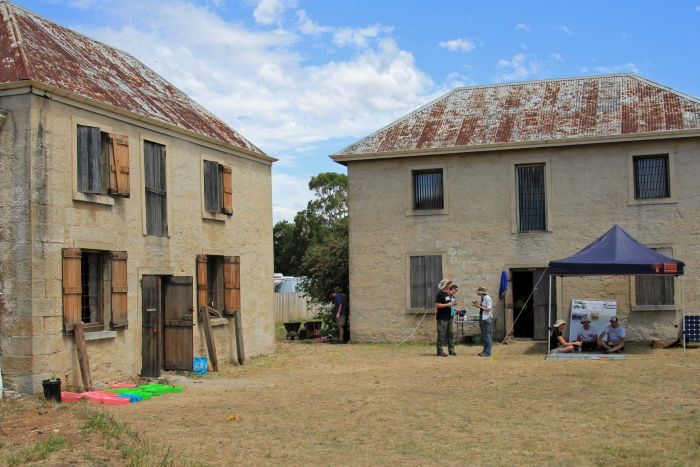Triabunna dig unearths gunpowder bags, poison bottles and toys at potential barracks site
Posted
 Photo:
Tasmania's history is being unearthed fragment by fragment by researchers and students. (ABC Radio Hobart: Carol Rääbus)
Photo:
Tasmania's history is being unearthed fragment by fragment by researchers and students. (ABC Radio Hobart: Carol Rääbus)
"Weird" ceramics, a gunpowder bag, children's toys and even a poison bottle have been found at an archaeological dig in Triabunna on Tasmania's east coast.
The dig is taking place next to the Spring Bay Hotel on the main road in Triabunna; a site which is believed to have once been a British military barracks.
"Legend has it that it was the 51st Regiment," Dr Ash Lenton from the Australian National University (ANU) told Helen Shield on ABC Radio Hobart.
 Photo:
Dr Ash Lenton says they have evidence the British military was based at the site in Triabunna. (ABC Radio Hobart: Carol Rääbus)
Photo:
Dr Ash Lenton says they have evidence the British military was based at the site in Triabunna. (ABC Radio Hobart: Carol Rääbus)
The 51st Regiment made a name for itself after helping defeat Napoleon at the Battle of Waterloo.
It is known the regiment was posted to Van Diemen's Land decades after the battle, but so far there has been no solid evidence they were posted to Triabunna.
This is the second year that ANU and Sydney University archaeological researchers and students have dug at the site and they believe they have found evidence it was used by the military.
 Photo:
This gunpowder sack found on the site suggests the military was based there. (ABC Radio Hobart: Carol Rääbus)
Photo:
This gunpowder sack found on the site suggests the military was based there. (ABC Radio Hobart: Carol Rääbus)
"What we have found so far are things like metal plates, lead, which fit on the gunpowder sack," Dr Lenton said.
"[It] doesn't say the 51st Regiment, but it does say to me the military were here."
The dig is used as a hands-on practical teaching exercise for archaeology students.
It is also open to members of the public who want to get down and dirty.
 Photo:
Student Mikhaila Chaplin from Sydney University found an intact poison bottle (larger bottle held), and an ink bottle was also uncovered near a tree close to the road. (ABC Radio Hobart: Carol Rääbus)
Photo:
Student Mikhaila Chaplin from Sydney University found an intact poison bottle (larger bottle held), and an ink bottle was also uncovered near a tree close to the road. (ABC Radio Hobart: Carol Rääbus)
"This [dig] isn't all about macho army people, [we've got] more evidence of the wives and children who lived here with their officers," Dr Lenton said.
"Then we've got some really strange [ceramics] ... it's sort of different colours and different finishes on each side.
"It's not the straightforward stuff that was brought from England; maybe it was brought from Japan, maybe it came from America, but it's something weird that we haven't quite worked out yet."
 Photo:
A toothpaste jar lid, bone-handled toothbrush, a toy soldier, a Tasmanian haberdashery token, and fragments of a child's tea saucer have been found. (ABC Radio Hobart: Carol Rääbus)
Photo:
A toothpaste jar lid, bone-handled toothbrush, a toy soldier, a Tasmanian haberdashery token, and fragments of a child's tea saucer have been found. (ABC Radio Hobart: Carol Rääbus)
Dr James Flexner from Sydney University said the items said a lot about the lives of soldiers' families during the late 1800s.
"One of the interesting things about the site is the amount of material that we're finding that relates to children's activities," he said.
"We've also found things like fragments of slate pencils, fragments of writing slates."
 Photo:
Dr James Flexner says many archaeologists have a tendency towards OCD as he categorises everything found on the site. (ABC Radio Hobart: Carol Rääbus)
Photo:
Dr James Flexner says many archaeologists have a tendency towards OCD as he categorises everything found on the site. (ABC Radio Hobart: Carol Rääbus)
The owners of the property said once the dig was complete they planned to build accommodation on the site, along with displays and interpretations of the findings.
In the meantime, Dr Lenton said he would continue to enjoy uncovering the untold stories of the ordinary people who once lived there.
"It's people we're studying; we're not studying rocks or bits of pots or glass, we're trying to find out about the people and their lives."
Topics: archaeology, 19th-century, 20th-century, university-and-further-education, community-and-society, human-interest, triabunna-7190, sydney-2000, canberra-2600, hobart-7000









